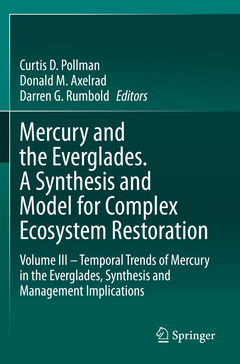Description
Mercury and the Everglades. A Synthesis and Model for Complex Ecosystem Restoration, 1st ed. 2020
Volume III – Temporal Trends of Mercury in the Everglades, Synthesis and Management Implications
Coordinators: Pollman Curtis D., Axelrad Donald M., Rumbold Darren G.
Language: English
Keywords
Ecosystem Restoration; Everglades; HG Cycling; Hydrology; Mercury
Publication date: 11-2021
164 p. · 15.5x23.5 cm · Paperback
Publication date: 11-2020
164 p. · 15.5x23.5 cm · Hardback
Description
/li>Contents
/li>Biography
/li>Comment
/li>
This book is the final installation in a three-volume series synthesizing 30 years of mercury research in the Florida Everglades. The first part of this book evaluates the occurrence of trends in both biota mercury concentrations and atmospheric mercury deposition. Through both empirical and deterministic analyses, the likely drivers of biota trends are identified. These analyses help lay the predicate for devising an overall strategy to mitigate and manage the Everglades mercury problem. The book concludes with a model analysis of the likely benefits and uncertainty attendant with implementing the leading candidate strategy for best reducing the Everglades mercury problem.
Donald M. Axelrad, Ph.D.<
The Florida Everglades is perhaps the world’s most studied aquatic ecosystem with respect to the mercury problem
This book integrates over 30 years of research on mercury sources, biogeochemistry, bioaccumulation and toxicity, and remediation options, to inform scientists and policy makers
This book reexamines Everglades’ mercury science and evaluates the likely efficacy of other solutions, as the proposed solution to the Everglades mercury problem by the State of Florida and accepted by the U.S. government will not result in toxicologically acceptable mercury levels in fish for many decades




